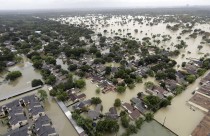COMMENTARY
The Hurricane Lull Couldn’t Last

The U.S. hadn’t been hit by a Category 3 or stronger storm since Katrina in 2005. We were overdue.
By Roger Pielke Jr. Aug. 31, 2017 7:09 p.m. ET
Activists, journalists and scientists have pounced on the still-unfolding disaster in Houston and along the Gulf Coast in an attempt to focus the policy discussion narrowly on climate change. Such single-issue myopia takes precious attention away from policies that could improve our ability to prepare for and respond to disasters. More thoughtful and effective disaster policies are needed because the future will bring many more weather disasters like Hurricane Harvey, with larger impacts than those of the recent past.
For many years, those seeking to justify carbon restrictions argued that hurricanes had become more common and intense. That hasn’t happened. Scientific assessments, including those of the Intergovernmental Panel on Climate Change and the U.S. government’s latest National Climate Assessment, indicate no long-term increases in the frequency or strength of hurricanes in the U.S. Neither has there been an increase in floods, droughts and tornadoes, though heat waves (Icecap Note: not really) and heavy precipitation have become more common.
Prior to Harvey, which made landfall as a Category 4 storm, the U.S. had gone a remarkable 12 years without being hit by a hurricane of Category 3 strength or stronger. Since 1970 the U.S. has only seen four hurricanes of Category 4 or 5 strength. In the previous 47 years, the country was struck by 14 such storms. President Obama presided over the lowest rate of hurricane landfalls -0.5 a year - of any president since at least 1900. Eight presidents dealt with more than two a year, but George W. Bush (18 storms) is the only one to have done so since Lyndon B. Johnson. The rest occurred before 1960.
Without data to support their wilder claims, climate partisans have now resorted to shouting that every extreme weather event was somehow “made worse” by the emission of greenhouse gases. Earlier this week, New York Times columnist David Leonhardt directed researchers “to shed some of the fussy over-precision about the relationship between climate change and weather.”
[...]
Wall Street Journal
And some bad news for the alarmists…

Gulf of Mexico operators returning to work after Harvey
09/01/2017
Offshore staff
NEW ORLEANS - About 9% of oil production and 13% of natural gas production remains shut-in in the Gulf of Mexico, according to the Bureau of Safety and Environmental Enforcement.
[...]
BSEE added that no damage reports from oil and gas operators have been received.
[...]
As offshore oil and gas operations return to normal, the industry continues to provide assistance for the onshore Hurricane Harvey relief efforts.
Hess Corp. has donated $1 million to the Hurricane Harvey Relief Fund. The company said that it will match every donation employees make in the coming weeks to relief efforts by the Hurricane Harvey Relief Fund, American Red Cross, and United Way of Houston.
Transocean says that it has contributed $100,000 to the American Red Cross and $100,000 to the Houston Food Bank. The company says that it will also match donations made to the relief efforts by its employees.
Statoil announced via social media that it has donated $250,000 to the Red Cross.
Weatherford International plc says that is has pledged $25,000 to Feeding Texas, the Texas Food Bank Network, and $25,000 to J.J. Watt’s Hurricane Harvey Relief Fund.
ExxonMobil says that it has increased its financial commitment for Harvey relief to up to $9.5 million, which includes a new employee and retiree donation match program and in-kind donations to the American Red Cross for recovery efforts in South Texas. The increased support builds on $1 million in previous contributions to the American Red Cross and United Way of Greater Houston.
Offshore Magazine




